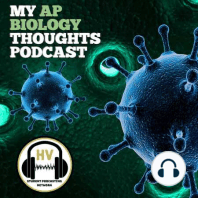5 min listen
Enzyme Activators and Inhibitors
ratings:
Length:
5 minutes
Released:
May 14, 2021
Format:
Podcast episode
Description
My AP Biology Thoughts Unit 3 Cellular EnergeticsWelcome to My AP Biology Thoughts podcast, my name is Chloe McGregor and I am your host for episode #65 called Unit 3 Cellular Energetics: Enzyme activators and inhibitors. Today we will be discussing the role of activators and inhibitors in enzyme activity. Segment 1: Introduction to activators and inhibitors It is important to understand the enzyme substrate complex first. Substrates and Enzymes are extremely specific to one another regarding the shape and charge of the site at which they bond. This site is called the active site. Each different substrate utilizes a specific enzyme, and is broken down from there. However, enzyme activity can be altered by both inhibitors and activators. More specifically, inhibitors are often disadvantageous as they decrease the rate at which the enzyme can work. On the other hand, activators work in order to turn enzymes back on so they can work. There are so many processes going on in the body which are not all happening at the same time. Because of this, enzymes are often deactivated, and not at work. This is why activators are so important because they activate the enzyme in order for it to function again. Segment 2: More About Enzyme activators and inhibitors To go more in depth, there are 2 types of enzyme inhibitors. Competitive inhibitors attach to the active site of the enzyme which prevents the substrate from binding to the enzyme. This is known as competitive inhibition because the substrate is competing with the inhibitor for the active site. To combat this, you can increase the substrate concentration in order to ultimately outcompete the inhibitors. Another type of inhibitor is the noncompetitive inhibitor. This is when it attaches to a different site on the enzyme causing the enzyme to change shape which prevents any substrate from binding at all. Another word for this is allosteric regulation. This inhibition can not be combatted because the enzyme changes shape, so increasing the substrate concentration would have no impact at all. In addition to these common inhibitors, feedback inhibition is when the final product of a reaction acts as an inhibitor to the first enzyme. This shuts down the pathway, and can be done either competitively or noncompetitively. There are also two branches of activators. Allosteric activation is when a new molecule binds to a different site on the enzyme to open the active site back up. Phosphorylation, on the other hand, happens when the existing protein structure is chemically modified. An example of this can be shifting a hydrophobic region to a hydrophilic region to allow certain reactions to occur. Phosphorylation also opens back up the active site similar to allosteric activation, however there is no outside molecule. Segment 3: Connection to the Course Inhibitors and activators are important in the greater scheme of things. In terms of cell energetics, both cellular respiration and photosynthesis are metabolic pathways. This means that there are a ton of tiny steps involved each utilizing different enzymes. In terms of activators, it is important that enzymes are activated and ready to catalyze a reaction when it is time. Oxidative phosphorylation is a great example of enzyme activation which is so crucial in order to make a...
Released:
May 14, 2021
Format:
Podcast episode
Titles in the series (100)
Homologous and Analogous Structures by My AP Biology Thoughts
